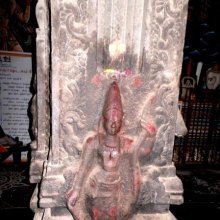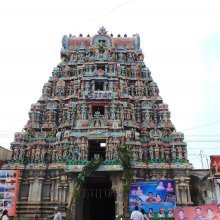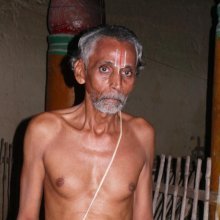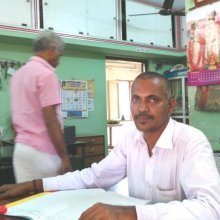Mahamandapa, Mahāmaṇḍapa, Maha-mandapa, Mahāmandapa: 5 definitions
Introduction:
Mahamandapa means something in Buddhism, Pali, Hinduism, Sanskrit, the history of ancient India. If you want to know the exact meaning, history, etymology or English translation of this term then check out the descriptions on this page. Add your comment or reference to a book if you want to contribute to this summary article.
Images (photo gallery)
In Hinduism
Vastushastra (architecture)
Source: Shodhganga: Temples of Salem region Up to 1336 ADMahāmaṇḍapa (महामण्डप) is the pavilion constructed right in front of the gūḍhamaṇḍapa of the temple and it is always bigger in dimensions than those of the gūḍhamaṇḍapa, therefore it is called by the name mahāmaṇḍapa. Its axis is common to the axis of the main temple. The plan of the mahāmaṇḍapa may also vary from place to place and from time to time. Its plan may be square or rectangular, with or without indentations. A rare instance of a mahāmaṇḍapa having a stellate plan is also noticed.

Vastushastra (वास्तुशास्त्र, vāstuśāstra) refers to the ancient Indian science (shastra) of architecture (vastu), dealing with topics such architecture, sculpture, town-building, fort building and various other constructions. Vastu also deals with the philosophy of the architectural relation with the cosmic universe.
Shilpashastra (iconography)
Source: Shodhganga: The significance of the mūla-beras (śilpa)Mahāmaṇḍapa (महामण्डप) refers to the “transept on each side of the central hall” of the Hindu temple.—In a fully formed temple there may be a transept on each side of the central hall known as the mahāmaṇḍapa. All the principal parts of this structure are crowned by pyramidal towers. The tallest is the tower on the sanctum and the shortest is the one on the porch. All round the sanctum is a passage meant for circumambulation by the devotees. The mukha-maṇḍapa is the front hall in front of the shrine.

Shilpashastra (शिल्पशास्त्र, śilpaśāstra) represents the ancient Indian science (shastra) of creative arts (shilpa) such as sculpture, iconography and painting. Closely related to Vastushastra (architecture), they often share the same literature.
In Buddhism
Theravada (major branch of Buddhism)
Source: Pali Kanon: Pali Proper NamesA palace in Anuradhapura, probably in the Mahavihara, used by preachers. Maliyadeva Thera preached there the Chakka Sutta, when sixty monks became arahants. MA.ii.1024.
Theravāda is a major branch of Buddhism having the the Pali canon (tipitaka) as their canonical literature, which includes the vinaya-pitaka (monastic rules), the sutta-pitaka (Buddhist sermons) and the abhidhamma-pitaka (philosophy and psychology).
India history and geography
Source: Cologne Digital Sanskrit Dictionaries: Indian Epigraphical GlossaryMahāmaṇḍapa.—(SITI), a large pillared hall next to the ardha-maṇḍapa in a temple; also called mukha-maṇḍapa. Note: mahāmaṇḍapa is defined in the “Indian epigraphical glossary” as it can be found on ancient inscriptions commonly written in Sanskrit, Prakrit or Dravidian languages.

The history of India traces the identification of countries, villages, towns and other regions of India, as well as mythology, zoology, royal dynasties, rulers, tribes, local festivities and traditions and regional languages. Ancient India enjoyed religious freedom and encourages the path of Dharma, a concept common to Buddhism, Hinduism, and Jainism.
Languages of India and abroad
Sanskrit dictionary
Source: Cologne Digital Sanskrit Dictionaries: Monier-Williams Sanskrit-English DictionaryMahāmaṇḍapa (महामण्डप):—[=mahā-maṇḍapa] [from mahā > mah] n. Name of a vestibule in a celebrated Śaiva temple, [Religious Thought and Life in India 447.]
Sanskrit, also spelled संस्कृतम् (saṃskṛtam), is an ancient language of India commonly seen as the grandmother of the Indo-European language family (even English!). Closely allied with Prakrit and Pali, Sanskrit is more exhaustive in both grammar and terms and has the most extensive collection of literature in the world, greatly surpassing its sister-languages Greek and Latin.
See also (Relevant definitions)
Partial matches: Maha, Mandapa.
Full-text: Dvikhanda, Bhavani, Mukhamandapa, Makamantapam, Kurichchi, Vasudevanallur, Antarala, Tirukkuvalai, Ilaiyangudi, Angamangalam, Shukavaneshvara, Mandapa, Varadaraja, Malaya Mahadeva.
Relevant text
Search found 10 books and stories containing Mahamandapa, Mahāmaṇḍapa, Maha-mandapa, Mahā-maṇḍapa, Mahāmandapa; (plurals include: Mahamandapas, Mahāmaṇḍapas, mandapas, maṇḍapas, Mahāmandapas). You can also click to the full overview containing English textual excerpts. Below are direct links for the most relevant articles:
Later Chola Temples (by S. R. Balasubrahmanyam)
Temples in Tirukkodikka (Tirukkodikkaval) < [Chapter IV - Temples of Vikrama Chola’s Time]
Temples in Toludur < [Chapter XII - Temples of Kulottunga III’s Time]
Temples in Ponnamaravati < [Chapter VIII - Temples of Rajaraja II’s Time]
Middle Chola Temples (by S. R. Balasubrahmanyam)
Temples in Tirunelveli < [Chapter II - Temples of Rajaraja I’s Time]
Temples in Gangaikondasolapuram (Gangaikondacholapuram) < [Chapter IV - Temples of Rajendra I’s Time]
Temples in Malurpatna < [Chapter II - Temples of Rajaraja I’s Time]
Temples of Munnur (Historical Study) (by R. Muthuraman)
Sri Prakannayagi Amman Shrine < [Chapter 4]
Madavarayan mandapa < [Chapter 4]
Ammaiyappan Sri Pallavandon Rajanarayana Sambuvarayan < [Chapter 1]
Sripura (Archaeological Survey) (by Bikash Chandra Pradhan)
Stone Images (3): Vaisnava Images < [Chapter 3 - Sculptural Programme]
Siva Temples at Sripura (Introduction) < [Chapter 2 - The Architectural Panorama]
Temples in and around Madurantakam (by B. Mekala)
Appendix 2: Thiru Venkateswara (Kadapperi) Temple Layout
Appendix 3: Thiru Aatcheeswarar Temple Layout
Early Chola Temples (by S. R. Balasubrahmanyam)
Temples in Tiruvamattur (3rd year) < [Chapter X - Historical Survey]
Temples in Vriddhachalam < [Chapter VIII - Temples of Uttama Chola’s Time]
Temples in Tiruvamattur < [Chapter II - Temples of Parantaka I’s Time]



